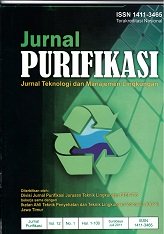BIOREMEDIASI LAHAN TERCEMAR MINYAK TANAH DENGAN METODA BIOPILE
Main Article Content
Abstract
Biopile is one of several bioremediation methods in compost production process. A pile of compost in general is used as loosening material to increase porosity by providing better permeability. The aim of this research were to remove hydrocarbon contaminant in soils, and to identify soil microorganisms, which degraded the hydrocarbon using compost biopile technique. Kerosene was used as the hydrocarbon compound. Reactors, which were equipped with aerators, were prepared for conducting this research. Variations of compost addition were 15%, 20%, 25%, and 30% of the reactor volume, whereas the microorganism composition were 8%, 10%, 12%, and 14% of the reactor volume. Environmental condition of the reactor was maintained at pH values of 6-9, temperature of 27-30ºC, and soil humidity of 50-75%, with air supply of 2 kPa. The results of this research showed that the optimal removal of Total Petroleum Hydrocarbon (TPH) was obtained at compost addition variation of 25% with microorganism composition of 14%. The optimum TPH removal efficiency was 84.08%. The TPH removal occurred optimally in temperature range of 28-30ºC, pH range of 6.61-6.94, and humidity range of 48.83-76.58%. Microorganisms which degraded the hydrocarbon compound comprised Micrococcus (family Micrococcaceae), Spirillum (family Spirillaceae) and Bacillus (family Bacillaceae).
Downloads
Article Details
Submission of a manuscript to Jurnal Purifikasi means that the work has never been published in another journal and is not under consideration for publication elsewhere. The author hereby agrees to submit the copyright of the manuscript and its contents to Jurnal Purifikasi, if accepted for publication. Accepted manuscripts will be published in printed form where the ISSN is bound in printed form, not in online form (pdf). Authors are not allowed to publish their work in other forms (journals) without permission from the Jurnal Purifikasi manager.
By submitting a manuscript, the author is deemed to know all the rights and obligations attached to each manuscript.








